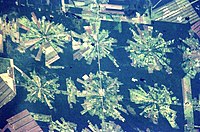
Photo from wikipedia
Seafloor multiparametric fibre-optic-cabled video observatories are emerging tools for standardized monitoring programmes, dedicated to the production of real-time fishery-independent stock assessment data. Here, we propose that a network of cabled… Click to show full abstract
Seafloor multiparametric fibre-optic-cabled video observatories are emerging tools for standardized monitoring programmes, dedicated to the production of real-time fishery-independent stock assessment data. Here, we propose that a network of cabled cameras can be set up and optimized to ensure representative long-term monitoring of target commercial species and their surrounding habitats. We highlight the importance of adding the spatial dimension to fixed-point-cabled monitoring networks, and the need for close integration with Artificial Intelligence pipelines, that are necessary for fast and reliable biological data processing. We then describe two pilot studies, exemplary of using video imagery and environmental monitoring to derive robust data as a foundation for future ecosystem-based fish-stock and biodiversity management. The first example is from the NE Pacific Ocean where the deep-water sablefish (Anoplopoma fimbria) has been monitored since 2010 by the NEPTUNE cabled observatory operated by Ocean Networks Canada. The second example is from the NE Atlantic Ocean where the Norway lobster (Nephrops norvegicus) is being monitored using the SmartBay observatory developed for the European Multidisciplinary Seafloor and water column Observatories. Drawing from these two examples, we provide insights into the technological challenges and future steps required to develop full-scale fishery-independent stock assessments.
Journal Title: Ices Journal of Marine Science
Year Published: 2020
Link to full text (if available)
Share on Social Media: Sign Up to like & get
recommendations!